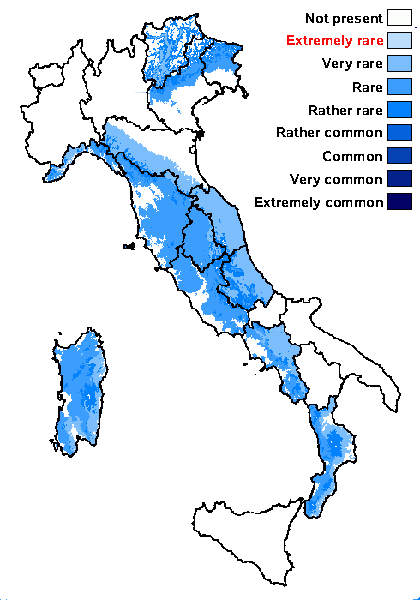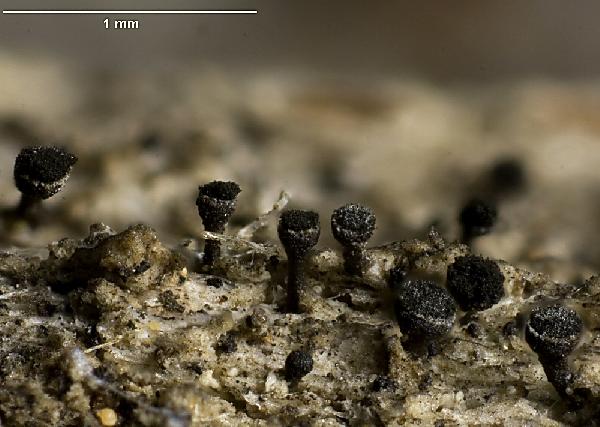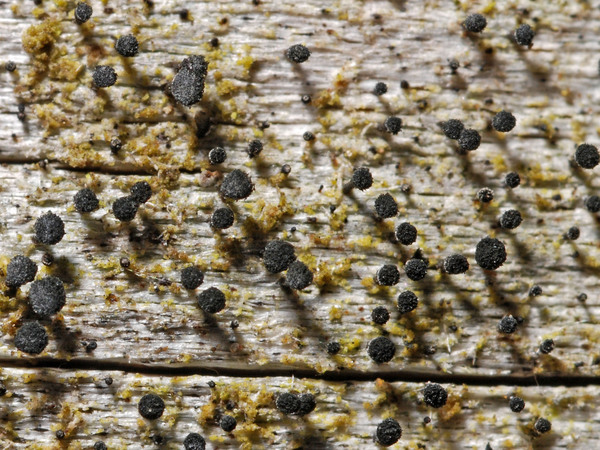Calicium glaucellum Ach.
Meth. Lich.: 97, 1803.
Synonyms: Calicium discoidale Ach.
Distribution: N - Frl (Puntillo & Puntillo 2009), Ven (Nascimbene 2008c), TAA (Nascimbene 2008b, 2013, Nascimbene & al. 2009, 2010, 2022, Nimis & al. 2015), Emil (Benesperi 2009, Fariselli & al. 2020), Lig (Herb. von Brackel 22). C - Tosc (Benesperi 2007, Puntillo & Puntillo 2009), Marc (Nimis & Tretiach 1999, Umb (Ravera 1998, Ravera & al. 2006, Puntillo & Puntillo 2009), Laz (Ravera 2001, Puntillo & Puntillo 2009), Abr (Puntillo & Puntillo 2009), Sar (Zedda 2002, 2002b, Puntillo & Puntillo 2009, Cossu 2013). S - Camp (Puntillo & Puntillo 2009), Cal (Puntillo 1994, 1996, Puntillo & Puntillo 2009).
Description: Thallus crustose, thin, endosubstratic and poorly evident or rarely thinly episubstratic and granular-verrucose, dark grey-green. Apothecia stalked, pin-like, black with a thin whitish pruina which is most abundant at the edge and on the lower side of capitulum, or more rarely epruinose. Stalk shiny black, sometimes white-pruinose in the uppermost part, 0.5-0.9 mm high, 0.1-0.2 mm thick, of strongly sclerotized, dark brown to dark aeruginose, irregularly interwoven hyphae, the outer layer covered with a thin, transparent gelatinous sheath. Capitulum lenticular to obovoid, 0.2-0.35 mm across, with a well-developed, cup-shaped exciple formed by dark brown to aeruginose, elongated to almost isodiametric, anticlinally arranged, sclerotized hyphae which are paler close to the surface; mazaedium well developed, black; hypothecium dark, with a flat or slightly convex upper surface. Asci cylindrical, formed singly, dissolving early, with uniseriate ascospores. Ascospores 1-septate, dark brown, ellipsoid, 9-13 x 5-7 µm, with a thick, ornamented wall; young spores with mainly longitudinally arranged ridges, mature spores with irregular cracks and short ridge fragments. Photobiont chlorococcoid. Spot tests: thallus K- or K+ dull yellow, C-, KC-, P-; ascomata I- in all parts. Chemistry: thallus with sekikaic acid (major) and related compounds. Note: a temperate to boreal-montane, holarctic species found on lignum and on acid bark, especially on decorticated stumps of conifers, but also on broad-leaved trees, e.g. on Castanea, widespread throughout Italy.
Growth form: Crustose
Substrata: bark and lignum
Photobiont: green algae other than Trentepohlia
Reproductive strategy: mainly sexual
In underhangs rarely wetted by rain
Commonnes-rarity: (info)
Alpine belt: absent
Subalpine belt: absent
Oromediterranean belt: absent
Montane belt: rather rare
Submediterranean belt: very rare
Padanian area: absent
Humid submediterranean belt: rare
Humid mediterranean belt: absent
Dry mediterranean belt: absent

Predictive model
Herbarium samples


P.L. Nimis; Owner: Department of Life Sciences, University of Trieste
Herbarium: TSB (11888)
2001/12/05

Courtesy: Olivier et Danièle Gonnet - Source: https://www.afl-lichenologie.fr/Photos_AFL/Photos_AFL_C/Textes_C3/Calicium_glaucellum.htm
France, 22/8/2016 - session AFL dans le Jura

Ulrich Kirschbaum CC BY-SA 4.0 - Source: https://www.thm.de/lse/ulrich-kirschbaum/flechtenbilder
Central Europe; Germany; Rheinland-Pfalz: Hunsrück.


Felix Schumm - CC BY-SA 4.0
[108], Germany, Baden-Württemberg, Kreis Göppingen, In der Nähe
des Herrenbachs bei der Mittelmühle unterhalb Kloster Adelberg, Stubensandsteingebiet,
an Fraxinus excelsior, TK: 7223. Leg. F. Schumm,
05.05.1968, det. V. Wirth. - Thallus K-; Sporen dunkel, zweizellig,
(10-12) x 6 μm, Köpfchen J-.


Felix Schumm - CC BY-SA 4.0
[108], Germany, Baden-Württemberg, Kreis Göppingen, In der Nähe
des Herrenbachs bei der Mittelmühle unterhalb Kloster Adelberg, Stubensandsteingebiet,
an Fraxinus excelsior, TK: 7223. Leg. F. Schumm,
05.05.1968, det. V. Wirth. - Thallus K-; Sporen dunkel, zweizellig,
(10-12) x 6 μm, Köpfchen J-.


Felix Schumm - CC BY-SA 4.0
[4196], Germany, Baden-Württemberg, Kreis Ludwigsburg, im
Krummbachtal zwischen Büsnau und Gerlingen, Waldrand östl. des
Rappenhofes; ca. 430 m, auf entrindetem altem ca. 2m hohen Baumstumpf,
sonnig und trocken, TK: 7220/NW. Leg. et det. F. Schumm,
02.05.1995.- Sporen schwarz, grob schollig warzig, zweizellig, in der
Mitte etwas eingeschnürt, 10,2 x (3,4-5,1) μm; Stiel und Apothecium
J-; Th. K+ mit unklarer braunroter Reaktion (vielleicht auch nur Holzfärbung);
Mazädium am Rd. weiß bereift.


Felix Schumm - CC BY-SA 4.0
[4196], Germany, Baden-Württemberg, Kreis Ludwigsburg, im
Krummbachtal zwischen Büsnau und Gerlingen, Waldrand östl. des
Rappenhofes; ca. 430 m, auf entrindetem altem ca. 2m hohen Baumstumpf,
sonnig und trocken, TK: 7220/NW. Leg. et det. F. Schumm,
02.05.1995.- Sporen schwarz, grob schollig warzig, zweizellig, in der
Mitte etwas eingeschnürt, 10,2 x (3,4-5,1) μm; Stiel und Apothecium
J-; Th. K+ mit unklarer braunroter Reaktion (vielleicht auch nur Holzfärbung);
Mazädium am Rd. weiß bereift.


Felix Schumm - CC BY-SA 4.0
[19311], Germany, Baden-Württemberg, Kreis Göppingen, Wangen,
zwischen Rotkreuz und Herrenmühle bei einer Waldhütte an Laubbaum,
ca. 48.7512° N, 9.5819° E, 482 m. Leg. F. Schumm, 27.03.2015,
det. Schumm. - Gehäuse am Rand ganz leicht weiß bereift, Stil und
Excipulum J-. Sporen grün-schwarz, 2-zellig, feinwarzig, 10-12 x 4-5
μm, mitunter etwas eingeschnürt.


Felix Schumm - CC BY-SA 4.0
[19311], Germany, Baden-Württemberg, Kreis Göppingen, Wangen,
zwischen Rotkreuz und Herrenmühle bei einer Waldhütte an Laubbaum,
ca. 48.7512° N, 9.5819° E, 482 m. Leg. F. Schumm, 27.03.2015,
det. Schumm. - Gehäuse am Rand ganz leicht weiß bereift, Stil und
Excipulum J-. Sporen grün-schwarz, 2-zellig, feinwarzig, 10-12 x 4-5
μm, mitunter etwas eingeschnürt.
Growth form: Crustose
Substrata: bark and lignum
Photobiont: green algae other than Trentepohlia
Reproductive strategy: mainly sexual
In underhangs rarely wetted by rain
Commonnes-rarity: (info)
Alpine belt: absent
Subalpine belt: absent
Oromediterranean belt: absent
Montane belt: rather rare
Submediterranean belt: very rare
Padanian area: absent
Humid submediterranean belt: rare
Humid mediterranean belt: absent
Dry mediterranean belt: absent

Predictive model
| Herbarium samples |


P.L. Nimis; Owner: Department of Life Sciences, University of Trieste
Herbarium: TSB (11888)
2001/12/05

Courtesy: Olivier et Danièle Gonnet - Source: https://www.afl-lichenologie.fr/Photos_AFL/Photos_AFL_C/Textes_C3/Calicium_glaucellum.htm
France, 22/8/2016 - session AFL dans le Jura

Ulrich Kirschbaum CC BY-SA 4.0 - Source: https://www.thm.de/lse/ulrich-kirschbaum/flechtenbilder
Central Europe; Germany; Rheinland-Pfalz: Hunsrück.


Felix Schumm - CC BY-SA 4.0
[108], Germany, Baden-Württemberg, Kreis Göppingen, In der Nähe des Herrenbachs bei der Mittelmühle unterhalb Kloster Adelberg, Stubensandsteingebiet, an Fraxinus excelsior, TK: 7223. Leg. F. Schumm, 05.05.1968, det. V. Wirth. - Thallus K-; Sporen dunkel, zweizellig, (10-12) x 6 μm, Köpfchen J-.


Felix Schumm - CC BY-SA 4.0
[108], Germany, Baden-Württemberg, Kreis Göppingen, In der Nähe des Herrenbachs bei der Mittelmühle unterhalb Kloster Adelberg, Stubensandsteingebiet, an Fraxinus excelsior, TK: 7223. Leg. F. Schumm, 05.05.1968, det. V. Wirth. - Thallus K-; Sporen dunkel, zweizellig, (10-12) x 6 μm, Köpfchen J-.


Felix Schumm - CC BY-SA 4.0
[4196], Germany, Baden-Württemberg, Kreis Ludwigsburg, im Krummbachtal zwischen Büsnau und Gerlingen, Waldrand östl. des Rappenhofes; ca. 430 m, auf entrindetem altem ca. 2m hohen Baumstumpf, sonnig und trocken, TK: 7220/NW. Leg. et det. F. Schumm, 02.05.1995.- Sporen schwarz, grob schollig warzig, zweizellig, in der Mitte etwas eingeschnürt, 10,2 x (3,4-5,1) μm; Stiel und Apothecium J-; Th. K+ mit unklarer braunroter Reaktion (vielleicht auch nur Holzfärbung); Mazädium am Rd. weiß bereift.


Felix Schumm - CC BY-SA 4.0
[4196], Germany, Baden-Württemberg, Kreis Ludwigsburg, im Krummbachtal zwischen Büsnau und Gerlingen, Waldrand östl. des Rappenhofes; ca. 430 m, auf entrindetem altem ca. 2m hohen Baumstumpf, sonnig und trocken, TK: 7220/NW. Leg. et det. F. Schumm, 02.05.1995.- Sporen schwarz, grob schollig warzig, zweizellig, in der Mitte etwas eingeschnürt, 10,2 x (3,4-5,1) μm; Stiel und Apothecium J-; Th. K+ mit unklarer braunroter Reaktion (vielleicht auch nur Holzfärbung); Mazädium am Rd. weiß bereift.


Felix Schumm - CC BY-SA 4.0
[19311], Germany, Baden-Württemberg, Kreis Göppingen, Wangen, zwischen Rotkreuz und Herrenmühle bei einer Waldhütte an Laubbaum, ca. 48.7512° N, 9.5819° E, 482 m. Leg. F. Schumm, 27.03.2015, det. Schumm. - Gehäuse am Rand ganz leicht weiß bereift, Stil und Excipulum J-. Sporen grün-schwarz, 2-zellig, feinwarzig, 10-12 x 4-5 μm, mitunter etwas eingeschnürt.


 Index Fungorum
Index Fungorum
 GBIF
GBIF















